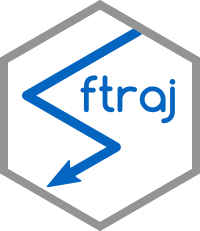After introducing the problem and our team in the previous blog
post, we now present in this second post of the
‘sftraj’ series a brief overview of the sftraj
package as projected, and how we will work to implement it. Most
importantly, we also ask your help, and explain how you (developers
and users!) can contribute to the success of sftraj.

Overview
We propose a sftraj package offering a generic and flexible approach
for a central trajectory class to support all stages of movement
studies (pre-processing, post-processing and analysis). The only aim
of the package will be to present this central class and basic
functions to build, handle, summarize and plot movement data. Our
project relies on three complementary pillars: a broad involvement of
the movement community, a robust conceptual data model, and a
sf-based implementation in R.
Project plan
All of the work is going to happen openly on GitHub, on the sftraj
repository. The code will be
released under the MIT license
for the package, a fully open license that allows for more
contributions, and wide acceptation by other package developers. Last
but not least, we abide by a strict code of
conduct
to enforce a safe and inclusive environment for the community
interested in sftraj.
The time frame of this project is over 6 months, until March 2020. Following the MoSCoW method, we determined what will be delivered from this project, starting from a minimum viable product to future development.
Must have
Must have are requirements necessary for project completion, which
define together our minimum viable product, i.e. a usable sftraj
package:
- Use cases described [month 1–2]
- Data model revisited and class definitions [month 3]
- Creators and converters from basic objects (
data.frames,sf, trajectories) [month 4] - Installable package (GitHub) [months 4–6]
- Accessors and summaries (
print,summary) [month 5] - Full function documentation and unit testing [months 5–6]
Should have
Should have are important requirements, which are however not necessary for project completion:
- Vignette [month 6]
Could have
Could have are desirable requirements developed if time allows:
- Package on CRAN (the package will be installable from GitHub as a must have)
- Basic plot (static) of trajectory object
Won’t have
Won’t have are requirements that are identified, but not planned at this stage of the work:
- Full-fledged package, including submission to CRAN and rOpenSci.
- Preparation of a detailed article (targeting the R
Journal) to present the technical
choices and the solution offered by
sftraj, in order to favor adoption by users and package developers. - Broad adoption by package developers, by continuing open conversation with them, and help them develop conversion tools to major existing classes.
- Dynamic visualization of trajectories, allowing keyboard- and
mouse-controlled exploration of trajectories, step by step (based on
the solution provided in
rpostgisLT).
How can you help?
Although we have set out a precise work plan, the very first step will decide if the package is successful and meet the requirements for broad acceptance by the movement community. Even before we start writing a single line of code, we need to precisely understand what is expected from such a package. This is the raison d’être of the use cases mentioned above. And this is why your contribution would be much critical, whether you are a package developer, an R guru, or simply a casual R user interested in movement data.
We need your feedback!
The idea is to collect all possible use cases for a trajectory object
in R. We know they are multiple, and will contribute our own use cases
— however, we want sftraj to be as useful as possible, and to act as
a center piece for movement in R, so we need you to tell us how you
would use it. In other words, we want to understand what you expect
from such a package, as a user or as a developer. For this, we ask
you to fill out special issues in the GitHub tracker of the package,
following the ‘Use case’
template.
Use cases do not need to be very complicated, but need to present a specific use in human terms, the technical requirements associated to it, and the input and output of the use case. Such use case could look like this:
[Use case] Amazing plot for trajectory
Use case:
Plot a trajectory using my
special_trajplotfunction, which shows [something amazing].Requirements:
spatial coordinates (x,y) as geographic coordinates with projection information
a time (t) as POSIXt object, ordered in time
information that identifies individuals (e.g. animal) for each location
data associated to each location directly accessible
Input: a
sftrajobjectOutput: a plot with [something amazing] about the trajectory
Additional information: See my
special_trajplotfunction here [with link].
Another example could be like this:
[Use case] Fill in missing locations in a sequence
Use case: Fill in the missing locations of a trajectory that contains spatial or temporal gaps. (for instance coming from GPS with failed fixes); In other words add in the missing values of a trajectory, i.e. timestamps with no geographic coordinates.
Requirements:
a time (t) as POSIXt object, ordered in time
information that identifies sequences of locations (optional, if several sequences), which could be different circuits of one individual, or different individuals, etc.
sftrajshould be capable of handling/storing missing valuesInput: a
sftrajobjectOutput: a
sftrajobject with additional timestamps for gaps (but otherwise identical in every way to the originalsftraj)Additional information: See
adehabitatLT::setNA, which does exactly that onltrajobjects.
What’s next?
While we are looking forward to your contributions (and add our own), we’ll be detailing the definitions and ideas we prepared for this package. We have a lot to say about it!
For the project team, Mathieu.